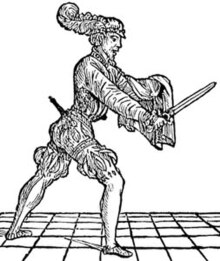
"Cloak and dagger" was a fighting style common in the Renaissance involving a knife hidden beneath a cloak. The term later came into use as a metaphor, referring to situations involving intrigue, secrecy, espionage, or mystery.

"Cloak and dagger" was a fighting style common in the Renaissance involving a knife hidden beneath a cloak. The term later came into use as a metaphor, referring to situations involving intrigue, secrecy, espionage, or mystery.
In "The Knight's Tale", published around 1400, English poet Geoffrey Chaucer referred to "The smiler with the knife under the cloak". [1]
Taken literally, the phrase could refer to using the cloak and dagger in historical European martial arts. The purpose of the cloak was to obscure the presence or movement of the dagger, to provide minor protection from slashes, to restrict the movement of the opponent's weapon, and to provide a distraction. Fencing master Achille Marozzo taught and wrote about this method of combat in his book, Opera Nova. Fighting this way was not necessarily seen as a first choice of weapons, but may have become a necessity in situations of self-defense if one were not carrying a sword, with the cloak being a common garment of the times that could be pressed into use as a defensive aid. Both Marozzo and other masters such as Di Grassi also taught the use of the cloak with the rapier. [2] [3]
The metaphorical meaning of the phrase dates from the early 19th century. It is a translation from the French de cape et d'épée and Spanish de capa y espada ("of cloak and sword"). These phrases referred to a genre of swashbuckler drama in which the main characters wore these items. In 1840, Henry Wadsworth Longfellow wrote, "In the afternoon read La Dama Duende of Calderón – a very good comedy of 'cloak and sword'." Charles Dickens subsequently used the phrase "cloak and dagger" in his work Barnaby Rudge a year later as a sarcastic reference to this style of drama. [4] The imagery of these two items became associated with the archetypal spy or assassin: the cloak, worn to hide one's identity or remain hidden from view, and the dagger, a concealable and silent weapon.[ citation needed ]
The sword fight in Peter Martins' ballet of Romeo + Juliet culminates in Romeo stabbing Tybalt repeatedly in the back with a dagger, having flung his cloak over the latter's head.
Cloak and Dagger are also the names of two Marvel Comics characters debuting in 1982.
The Spy in Team Fortress 2 owns a wristwatch called "The Cloak and Dagger", alluding to his affinity towards knives and backstabbing.
SEAL Team ONE's unit logo features a seal wrapped in a cloak, holding a dagger, referencing the nature of their clandestine missions.
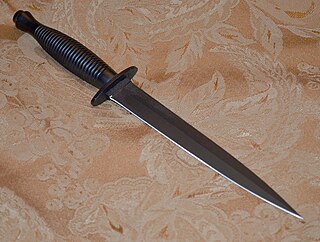
A dagger is a fighting knife with a very sharp point and usually one or two sharp edges, typically designed or capable of being used as a cutting or thrusting weapon. Daggers have been used throughout human history for close combat confrontations, and many cultures have used adorned daggers in ritual and ceremonial contexts. The distinctive shape and historic usage of the dagger have made it iconic and symbolic. A dagger in the modern sense is a weapon designed for close-proximity combat or self-defense; due to its use in historic weapon assemblages, it has associations with assassination and murders. Double-edged knives, however, play different sorts of roles in different social contexts.

A rapier or espada ropera is a type of sword used in Renaissance Spain to designate a sword with a straight, slender and sharply pointed two-edged long blade wielded in one hand. It was widely popular in Western Europe throughout the 16th and 17th centuries as a symbol of nobility or gentleman status.

Stage combat, fight craft or fight choreography is a specialised technique in theatre designed to create the illusion of physical combat without causing harm to the performers. It is employed in live stage plays as well as operatic and ballet productions. With the advent of cinema and television the term has widened to also include the choreography of filmed fighting sequences, as opposed to the earlier live performances on stage. It is closely related to the practice of stunts and is a common field of study for actors. Actors famous for their stage fighting skills frequently have backgrounds in dance, gymnastics or martial arts training.
George Silver was a gentleman of England during the late 16th and early 17th centuries, who is known for his writings on swordplay. He is thought to have been the eldest of four brothers, and eleventh in descent from Sir Bartholomew Silver, who was knighted by Edward II. He married a woman named Mary Haydon in London, in 1580. Silver's activities after the publication of his book are unclear. The fencing historian Aylward claims that he was alive in 1622, when he was visited by Cooke, Clarenceux King-of-Arms. However, Robert Cooke died in 1593. The Clarenceux King-of Arms in 1622 was William Camden, but as he became paralyzed in 1622 and died in 1623 it is doubtful whether he visited Silver either.

Swordsmanship or sword fighting refers to the skills and techniques used in combat and training with any type of sword. The term is modern, and as such was mainly used to refer to smallsword fencing, but by extension it can also be applied to any martial art involving the use of a sword. The formation of the English word "swordsman" is parallel to the Latin word gladiator, a term for the professional fighters who fought against each other and a variety of other foes for the entertainment of spectators in the Roman Empire. The word gladiator itself comes from the Latin word gladius, which is a type of sword.
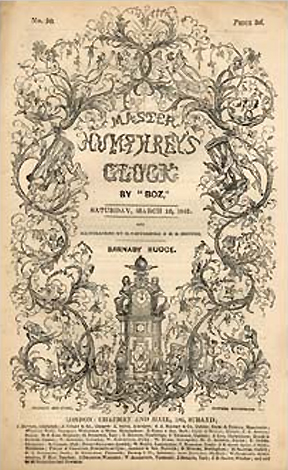
Barnaby Rudge: A Tale of the Riots of Eighty is a historical novel by British novelist Charles Dickens. Barnaby Rudge was one of two novels that Dickens published in his short-lived (1840–1841) weekly serial Master Humphrey's Clock. Barnaby Rudge is largely set during the Gordon Riots of 1780.
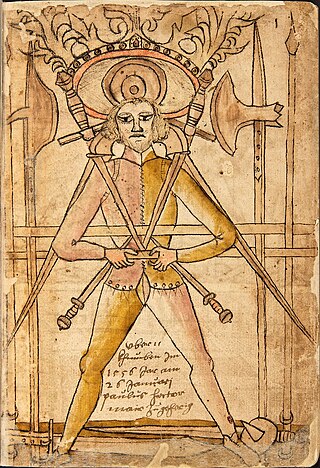
Historical European martial arts (HEMA) are martial arts of European origin, particularly using arts formerly practised, but having since died out or evolved into very different forms.

Master Humphrey's Clock was a weekly periodical edited and written entirely by Charles Dickens and published from 4 April 1840 to 4 December 1841. It began with a frame story in which Master Humphrey tells about himself and his small circle of friends, and their penchant for telling stories. Several short stories were included, followed by the novels The Old Curiosity Shop and Barnaby Rudge. It is generally thought that Dickens originally intended The Old Curiosity Shop as a short story like the others that had appeared in Master Humphrey's Clock, but after a few chapters decided to extend it into a novel. Master Humphrey appears as the first-person narrator in the first three chapters of The Old Curiosity Shop but then disappears, stating, "And now that I have carried this history so far in my own character and introduced these personages to the reader, I shall for the convenience of the narrative detach myself from its further course, and leave those who have prominent and necessary parts in it to speak and act for themselves."
The baselard, Schwiizerdolch in Swiss-German is a historical type of dagger or short sword of the Late Middle Ages.

The term Italian school of swordsmanship is used to describe the Italian style of fencing and edged-weapon combat from the time of the first extant Italian swordsmanship treatise (1409) to the days of classical fencing.

Joachim Meyer was a self-described Freifechter living in the then Free Imperial City of Strasbourg in the 16th century and the author of a fechtbuch Gründtliche Beschreibung der Kunst des Fechtens first published in 1570.

Francesco Ferdinando Alfieri was a master of fencing of the 17th century. He was a representative of the Venetian school of fencing and “Maestro D’Arme” to the Accademia Delia in Padua in 1640. Alfieri was originally from Padua, which at that time was considered territory of the Venetian Republic.
Achille Marozzo (1484–1553) was an Italian fencing master, one of the most important teachers in the Dardi or Bolognese tradition.

Salvator Fabris (1544-1618) was an Italian fencing master from Padua. During his life he taught in various European countries, most notably in Denmark where he was the fencing instructor of King Christian IV. It was during his time in Copenhagen that he published his treatise on rapier fencing, Lo Schermo, overo Scienza d’Arme, in 1606. The treatise became a fencing bestseller around Europe, and was reprinted until 1713 and translated into several languages, notably into German, and again in 2005, into English.
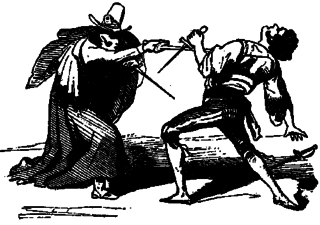
The parrying dagger is a category of small handheld weapons from the European late Middle Ages and early Renaissance. These weapons were used as off-hand weapons in conjunction with a single-handed sword such as a rapier. As the name implies they were designed to parry, or defend, more effectively than a simple dagger form, typically incorporating a wider guard, and often some other defensive features to better protect the hand as well. They may also be used for attack if an opportunity arises. The general category includes two more specific types, the sword breaker and trident dagger.
Bolognese Swordsmanship, also sometimes known as the Dardi school, is a tradition within the Italian school of swordsmanship which is based on the surviving fencing treatises published by several 16th century fencing masters of Bologna, As early as the 14th century several fencing masters were living and teaching in the city: a maestro Rosolino in 1338, a maestro Nerio in 1354, and a maestro Francesco in 1385.
The oldest surviving manual on western swordsmanship dates back to the 14th century, although historical references date fencing schools back to the 12th century.
Nova Scrimia is an Italian organisation which promotes the teaching of the Italian school of swordsmanship, of stick fencing, of short range fencing (dagger) and of unarmed fencing from the documented period that goes from the 15th century to the 20th century. Nova Scrimia is currently represented in Italy and other European countries, in USA and in Mexico.
Italian martial arts include all those unarmed and armed fighting arts popular in Italy between the Bronze age until the 19th century AD. It involved the usage of weapons. Each weapon is the product of a specific historical era. The swords used in Italian martial arts range from the Bronze daggers of the Nuragic times to the gladius of the Roman legionaries to swords which were developed during the renaissance, the baroque era and later. Short blades range from medieval daggers to the liccasapuni Sicilian duelling knife.

The Renaissance Sword Club is a historical European martial arts group based in London, South East of England and Brittany, France. It was founded in 2013 by Rob Runacres. Its primary aim is the research and recreation of European swordsmanship of the sixteenth and seventeenth centuries, specifically those concerned with the rapier and spada da lato, as well as their companion weapons such as the dagger, cloak, buckler and rotella. Members have also pursued interests outside of the core curriculum in to staff weapons, longsword and small sword.
...his servant brought in a very small scrap of dirty paper, tightly sealed in two places, on the inside whereof was inscribed in pretty large text these words: A friend. Desiring of a conference. Immediate. Private. Burn it when you've read it. "Where in the name of the Gunpowder Plot did you pick up this?" said his master. "It was given him by a person then waiting at the door", the man replied. "With a cloak and dagger?" said Mr Chester.